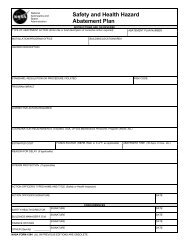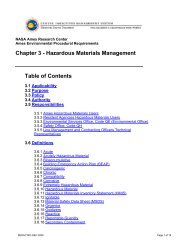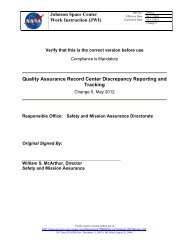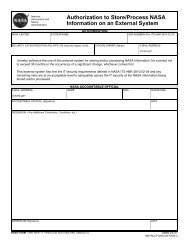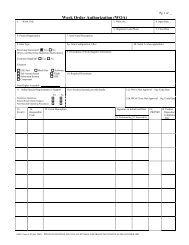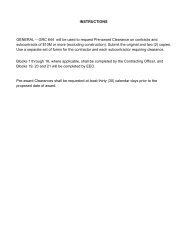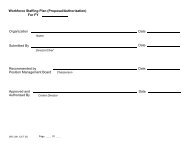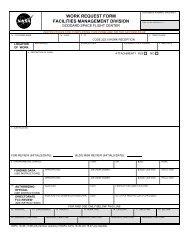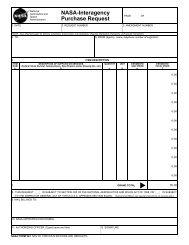JPR 8550.1 - Nasa
JPR 8550.1 - Nasa
JPR 8550.1 - Nasa
Create successful ePaper yourself
Turn your PDF publications into a flip-book with our unique Google optimized e-Paper software.
JSC Environmental Compliance<br />
Procedural Requirements<br />
<strong>JPR</strong> No.<br />
<strong>8550.1</strong>A XXXX.X<br />
Effective Date:<br />
Johnson Space Center • Environmental Compliance Program<br />
Expiration Date:<br />
Expiration Date:<br />
Page Number<br />
3/25/2011<br />
3/25/2016<br />
[Leave Blank]<br />
Page 37 of 123<br />
(3) Use roll-off containers with tarps to keep storm water from contacting wastes.<br />
(4) Contact the EO immediately if the roll-off collects storm water.<br />
(5) Minimize odors, fugitive dust, and air emissions from the roll-off container.<br />
(6) Make sure drain holes are closed and that plugs are available and operational, if<br />
applicable. Verify that plugged openings are not leaking prior to placing roll-off in use.<br />
(7) Check daily to make sure that only approved ISW (refer to JF1104 Form ―Waste<br />
Notification‖) has been placed in the roll-off container.<br />
(8) Tie down the container tarp at the end of each day (at a minimum).<br />
(9) The EO shall conduct an inspection of all hazardous waste roll-offs and surrounding areas<br />
each week.<br />
3.9.4 Miscellaneous Accumulation Devices<br />
a. Generators shall adhere to the following requirements for the accumulation of ISW in other<br />
types of accumulation devices:<br />
(1) Obtain approval by the EO before tanks and other devices are brought on-site or placed<br />
into service by following the steps outlined in Chapter 2 Environmental Planning.<br />
(2) Inspect approved accumulation or storage devices and ensure devices are free of<br />
contamination prior to being put into service.<br />
(3) Keep the device or tank closed except when actively filling or emptying it.<br />
(4) If the total volume of liquid accumulated or stored is greater than 55 gallons and is<br />
outdoors, obtain a secondary containment structure. The secondary containment structure<br />
must be impervious and be able to hold the entire volume of the largest single container plus a<br />
10-inch rainfall amount. Contact the EO for additional requirements.<br />
(5) Periodically inspect containment structures, and evaluate and remove any accumulated<br />
storm water. The Facilities Contractor is responsible for inspection and removal of liquids from<br />
containments. Other individuals are prohibited from draining containments or removing drain<br />
caps. If you see that a containment structure is leaking, full or overflowing, or contains spilled<br />
ISW or product, call Facilities Work Control at (X32038).<br />
(6) Call Facilities Work Control at (X32038) to request draining of storm water from secondary<br />
containments if an excessive accumulation or overflowing condition is observed.<br />
3.10 Waste Pickup Procedures<br />
Once a container is full or an accumulation time limit has been reached, the generator shall<br />
follow the instructions below for scheduling the ISW for pickup, subsequent transportation,<br />
Verify correct version before use at<br />
http://server-mpo.arc.nasa.gov/Services/CDMSDocs/Centers/JSC/Home.tml.<br />
JSC Form JF2420B (MS Word August 28, 2006) (Revised May 30, 2007)



